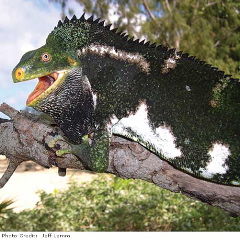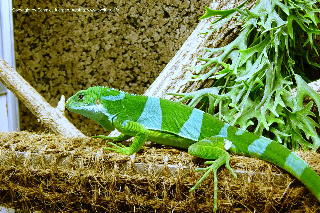Fiji: New Iguana Species Discovered
Posted by: Loren Coleman on September 16th, 2008

Brachylophus bulabula (male), Ovalau Island, Fiji. Photo: Peter S Harlow.
A team of Australian and US researchers have discovered a new species of iguana in the central regions of Fiji, which makes three living Pacific iguana species including one that is critically endangered. The study suggests that the ancestors of the Pacific iguanas arrived up to 13 million years ago after an 8000 kilometer rafting trip from the New World.

Fijian Crested Iguana, Brachylophus vitiensis. Photo: J. Lemm.
Detailed genetic and morphological analyses show that there are three living kinds of Brachylophus iguanas, not two as indicated in current taxonomy. Scientists named the newly revealed iguana species Brachylophus bulabula. The scientific name bulabula is a doubling of bula, the Fijian word for ‘hello,’ thus signifying an even more enthusiastic greeting.

Fijian Iguana, Brachylophus fasciatus. Photo: J. Schmidt.
“The iconic Fijian iguanas are famous for their beauty and also their unusual occurrence in the middle of the Pacific Ocean because all of their closest relatives are in the Americas”, said Scott Keogh, an Associate Professor at the Australian National University in Canberra, Australia, and lead author of the study.
The other coauthors of the study are Danielle Edwards at the Australian National University, Robert Fisher at the U.S. Geological Survey in San Diego, and Peter Harlow at Macquarie University in Australia.
The mystery of how the Pacific iguanas originally arrived has long puzzled biogeographers. Their closest relatives, found only in the New World, are separated by about 8,000 miles of ocean. The highest islands of Fiji have been above sea level for at least the last 16 million years, and the current study’s findings suggest that the Pacific iguanas, both extinct and living, were likely on the islands much of that time, following a long-distance rafting trip from the New World.
The Pacific iguanas have been adversely affected by human presence. Two species were eaten to extinction after people arrived nearly 3,000 years ago. The three living Brachylophus iguanas face threats from habitat loss and modification, and from feral cats, mongooses and goats.
The Fiji crested iguana, Brachylophus vitiensis, is now listed as Critically Endangered on the IUCN Red List. An important study finding regarding conservation of the genetic diversity in these iguanas is that, with only one exception, every island for which there were samples was represented by at least one distinct iguana lineage. The new discovery was published in a special themed edition of Philosophical Transactions of the Royal Society B, which pays tribute to Charles Darwin’s contribution to the Pacific region. ~ Australian National University, Science Alert, other sources.
About Loren Coleman
Loren Coleman is one of the world’s leading cryptozoologists, some say “the” leading living cryptozoologist. Certainly, he is acknowledged as the current living American researcher and writer who has most popularized cryptozoology in the late 20th and early 21st centuries.
Starting his fieldwork and investigations in 1960, after traveling and trekking extensively in pursuit of cryptozoological mysteries, Coleman began writing to share his experiences in 1969. An honorary member of Ivan T. Sanderson’s Society for the Investigation of the Unexplained in the 1970s, Coleman has been bestowed with similar honorary memberships of the North Idaho College Cryptozoology Club in 1983, and in subsequent years, that of the British Columbia Scientific Cryptozoology Club, CryptoSafari International, and other international organizations. He was also a Life Member and Benefactor of the International Society of Cryptozoology (now-defunct).
Loren Coleman’s daily blog, as a member of the Cryptomundo Team, served as an ongoing avenue of communication for the ever-growing body of cryptozoo news from 2005 through 2013. He returned as an infrequent contributor beginning Halloween week of 2015.
Coleman is the founder in 2003, and current director of the International Cryptozoology Museum in Portland, Maine.










Is it 8,000 miles or kilometers? Anyway it’s an astounding distance, and it’s kind of ironic that modern Science can entertain the possibility that these marvelous iguanas could endure such a trip on a raft —with WHAT supplies??— but the idea of a living large unknown primate living in North America is preposterous.
Then again, the reason Science comes up with the raft idea is simple: the iguanas are there, their existence is undisputable, and now you have to figure out how they got from here to there. After Bigfoot’s existence is confirmed, I believe many wild theories of how it got to the New World will be proposed, but once Science accepts Bigfoot as real, those theories won’t seem so preposterous to begin with.
I always have to wonder about the time line for islands. Millions of years is quite a long time for some islands to form and stay without something causing their demise. Are we sure it wasn’t the other way around? If the island was suppose to be there that long, there’s no reason that the iguanas didn’t migrate along with the Polynesians, finally making it to the Galapagos islands. From there the swim is nothing for them (almost surfing most of it).
I think the explaination is much simpler. The ancestors of the iguanas just lived in a wide range of Pangea before is broke apart.
wow, these rule. 🙂 Their so beautiful.. I like the 2nd one.:)
cute. 🙂
I would love to see a 5ft Iguana